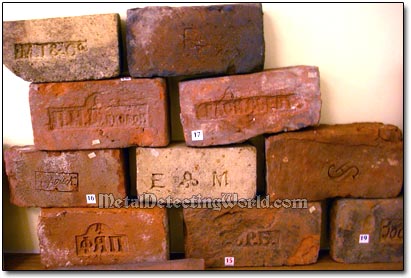Metal Detecting Research and Exploration - A Complete Guide, page 58
Footwork and Observation
TRANSECTING THE FARM FIELDS TO LOCATE SITES OF FORMER DWELLINGS
Transecting the farm field - field walking and observing, works best on either ploughed ground or surfaces with little vegetation, i.e. in the early Spring, because you have a better chance in spotting any irregularities on bare soil. These irregularities may be of many different types ranging from traces of the earthworks to regular artifacts.

SPOTTING IRON RELICS and ARTIFACTS
Some detectorists prefer to discover the hunt sites by crisscrossing the fields with metal detectors operated in All Metal mode. However, these guys usually have to cover large areas before hitting a spot with a cluster of iron signals - a potential site of former homestead or village. In most cases, these detectorists get nothing but a lot of body pains and frustration. Metal detecting while traversing the field back and forth is effective only when you have to pinpoint the spot with confirmed location or cover a small square area. Otherwise this activity is just a huge waste of invaluable time and physical effort.
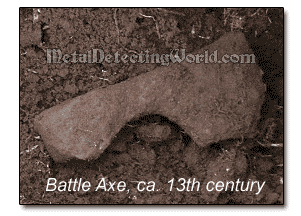
It is much easier and quicker to "travel light" while scouting the field without a metal detector and shovel, and just observing. If you know what to look for, you will not spend much time to find a desirable hunt site. On ploughed fields, as the soil is turned regularly, buried artifacts are gradually moving up to the top. Erosion and soil loss on uncultivated and lightly vegetated soil (e.g., in semi-arid environments) may cause artifacts to also "rise" to the surface.
However, spotting the small rusty iron artifacts and non-ferrous relics on the surface is not easy and sometimes impossible. It very much depends on how well your eyes have been trained to see the objects that are plastered with soil or mud. Being of the same color as the soil lumps of various sizes surrounding them, these objects are almost invisible on the surface. Only when you know what to expect and set your mind on objects of various shapes and sizes, you might be very successful in finding a "hot" spot. But there are more visible and helpful clues you can spot on the ground.
SPOTTING BRICK, LIMESTONE and SHALE FRAGMENTS
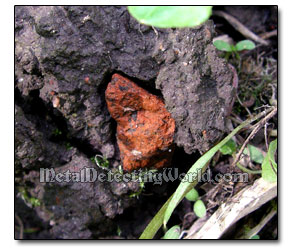 Unlike the dark-colored iron relics which are hard to spot on the ground surface, the brick fragments are well visible and have been the best indicators of the former settlement site.
Unlike the dark-colored iron relics which are hard to spot on the ground surface, the brick fragments are well visible and have been the best indicators of the former settlement site.
Over many years, zillions of rains and winds have cleaned the mud off these tiny fragments, and now they appear bright red on black or dark brown background of the soil surface. Their colors vary from light orange to dark raspberry.
I suggest to collect and mark a few small brick fragments at each hunt site in your area. If the hunt sites are dated to various time periods, you will be able to see the difference between various types of bricks; not only in color but also in their texture which varies from one century to another. If you learn how to date brick fragments and identify their origin correctly, this knowledge will be a great additional help to you in dating every metal detecting site you visit.
Depending on the area of search, you might find many fragments of flat stones scattered on the ground at the locations that were formerly inhabited. Limestone and shale are the most common types of stones to spot. Because they represent the oldest building material that was used before the age of bricks, shale fragments usually indicate the oldest hunt sites.
Limestone Fragments Found at Hunt Site in the Field
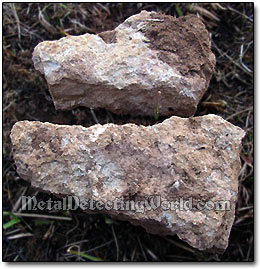
Sometimes both brick and stone fragments are present at the hunt site. Such a mix reflects a long period of existence of this particular place. In some areas, the soil is heavily mixed with stones, and it is easy to confuse natural stones with pieces of the medieval stone foundations or walkways, or completely miss these cultural clues scattered among natural stone pieces.
In this difficult case, one should familiarize oneself with local geology, rock types and soil content, compare the stones used for building fences with types of rocks found, and if they do not match, look for the atypical rocks on the ground. Otherwise, forget about the stone fragments and focus on other clues including the old good brick fragments. In any case, pieces of bricks will always be your loyal allies.
Brick Fragments Found at Hunt Site in the Field
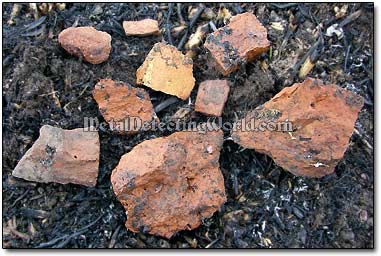
Collectible Bricks at Museum Exhibition
